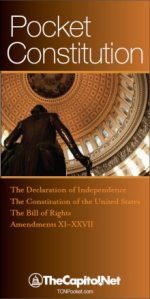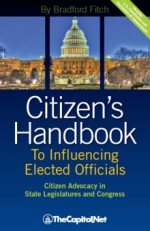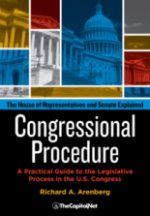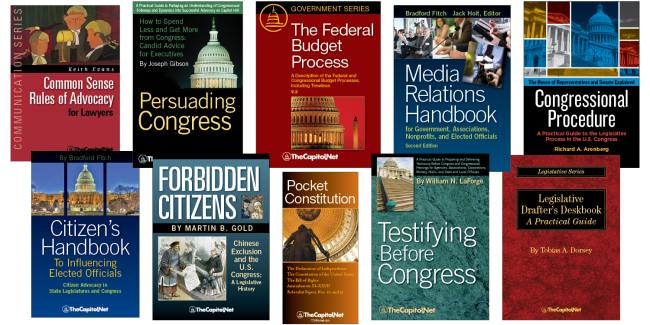From the Congressional Glossary – Including Legislative and Budget Terms
Presidential Succession
President Gerald Ford – Remarks on Taking the Oath of Office, August 9, 1974
Under Article II and the Twelfth, Twentieth, and Twenty-fifth Amendments to the Constitution, Congress has critical roles to play in the selection of the president and vice president during the quadrennial election process and in the event of a vacancy between elections.
Article II, Section 1, as modified by the Twelfth Amendment, established Congress’ role in the electoral college system. Under these constitutional provisions and federal law, Congress, in joint session on January 6 (or another date set by Congress) following a presidential election, receives and counts electoral votes, and the election of the president and vice president is announced. Congress is empowered to resolve objections regarding the electoral votes at that time.
In order to be elected president or vice president by the electoral college, a candidate must receive a majority, and not merely a plurality, of the electoral votes (currently 270 of 538). The Twelfth Amendment, as modified by the Twentieth Amendment, established a system for the contingent election of the president and vice president in the event that no candidate attains this threshold. In the case of the president, the House of Representatives chooses the president from among the three candidates with the largest numbers of electoral votes; each state delegation casts a single vote. A majority of states is needed for election. Although the Twenty-third Amendment to the Constitution provided electors for the District of Columbia, it did not provide the District with a role in a contingent election. In the event that no vice presidential candidate receives a majority of electoral votes, the Senate chooses between the two candidates with the largest numbers of electoral votes; each senator has one vote, and a majority of votes is needed for election.
The Twelfth Amendment was proposed by Congress in 1803 in response to difficulties encountered during the presidential election of 1800-1801. After ratification by the states, the Twelfth Amendment went into effect in 1804. There have been two contingent elections under its provisions. The president was elected by the House of Representatives in 1825, and the vice president was elected by the Senate in 1837. The Twelfth Amendment mandates some of the specific procedures that must be used during a contingent election. Other procedures were developed by the House and Senate during the respective contingent elections, but those procedures could be altered in the event of another contingent election.
America 101: Who is the Next in Line for Succession After the President? | History
The Twentieth Amendment provided that the vice president serve as acting president until the House is able to choose a president, should the House be unable to reach a decision by inauguration day, January 20. (The Twentieth Amendment provided that a president’s and vice president’s terms of office end at 12:00 noon on January 20 following a presidential election.) This amendment also allows Congress to establish by law who serves as acting president in the event that neither a president nor a vice president is qualified by January 20. In the Presidential Succession Act of 1947 (61 Stat. 380; 3 U.S.C. § 19), Congress addressed this matter, naming first the Speaker of the House, alternatively the president pro tempore of the Senate, and then the Cabinet secretaries in the order in which their departments were created (beginning with the secretary of state). To serve, an individual would need to meet the constitutional qualifications required for any president–a natural-born citizen, a resident of the United States for at least fourteen years, at least thirty-five years old, and not disqualified by previous service as president.
President
Vice President
Speaker of the House
President pro tempore
Secretary of State
Secretary of the Treasury
Secretary of Defense
Attorney General
Article II, Section 1, Clause 6 of the Constitution originally provided for presidential succession in the event of “the Removal of the President from Office, or of his Death, Resignation, or Inability to discharge the Powers and Duties of the said Office.” The Twenty-fifth Amendment, ratified in 1967, superseded this provision. It established a role for Congress in confirming a president’s nomination to fill a vice presidential vacancy. The amendment also provided a role in determining, under certain circumstances, whether a president was “unable to discharge the powers and duties of his office.”
Also see: Electoral College; House; Impeachment; Mid-Term Election; President of the United States; President pro tempore; Speaker; Vice President; § 8.90 Congress and the Executive: Presidential Election and Succession, § 8.100 Congress and the Executive: Impeachment, in Congressional Deskbook; Chapter 8.P. Presidential Succession in Congressional Procedure.
More
- Article II, Section 1
- Twelfth Amendment
- Twentieth Amendment
- Twenty-fifth Amendment
- United States presidential line of succession – Wikipedia
- “The seven stages of the office seeker“
- “Presidential Succession: Perspectives, Contemporary Analysis, and 110th Congress Proposed Legislation,” CRS Report RL34692 (35-page PDF
 )
) - “Presidential and Vice Presidential Succession,” CRS Report RL31761 (30-page PDF
 )
) - “The President-Elect: Succession and Disability Issues During the Transition Period,” CRS Report RS22992 (8-page PDF
 )
) - “Continuity of Operations (COOP) in the Executive Branch: Issues in the 109th Congress,” CRS Report RL32752 (26-page PDF
 )
) - “Continuity of Congress: Enacted and Proposed Federal Statutes for Expedited Election to the House in Extraordinary Circumstances,” CRS Report RL32958 (16-page PDF
 )
) - “Presidential Succession: Perspectives and Contemporary Issues for Congress,” CRS Report R46450 (36-page PDF
 )
) - “Continuity of Government: Current Federal Arrangements and the Future,” CRS Report RS21089 (8-page PDF
 )
) - “Contingent Election of the President and Vice President by Congress: Perspectives and Contemporary Analysis,” CRS Report R40504 (24-page PDF
 )
) - “Presidential Elections: Vacancies in Major-Party Candidacies and the Position of President-Elect,” CRS Report R44648 (14-page PDF
 )
) - Truman signs second Presidential Succession Act, July 18, 1947, History
Courses
- Congressional Operations Briefing – Capitol Hill Workshop
- Drafting Federal Legislation and Amendments
- Writing for Government and Business: Critical Thinking and Writing
- Custom, On-Site Training
- Drafting Effective Federal Legislation and Amendments in a Nutshell, Audio Course on CD
- Congress, the Legislative Process, and the Fundamentals of Lawmaking Series, a Nine-Course series on CD
Publications
CongressionalGlossary.com, from TheCapitol.Net
For more than 40 years, TheCapitol.Net and its predecessor, Congressional Quarterly Executive Conferences, have been teaching professionals from government, military, business, and NGOs about the dynamics and operations of the legislative and executive branches and how to work with them.
Our custom on-site and online training, publications, and audio courses include congressional operations, legislative and budget process, communication and advocacy, media and public relations, testifying before Congress, research skills, legislative drafting, critical thinking and writing, and more.
TheCapitol.Net is on the GSA Schedule, MAS, for custom on-site and online training. GSA Contract GS02F0192X
TheCapitol.Net is now owned by the Sunwater Institute.
Teaching how Washington and Congress work ™





